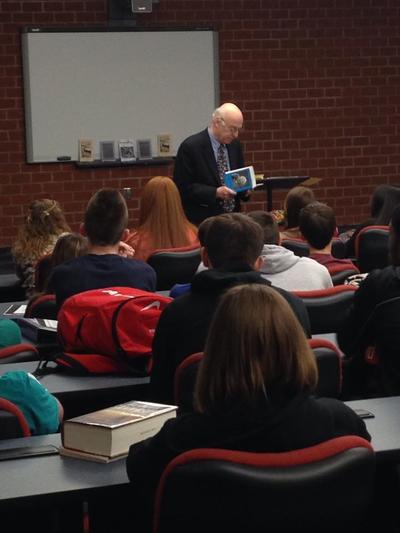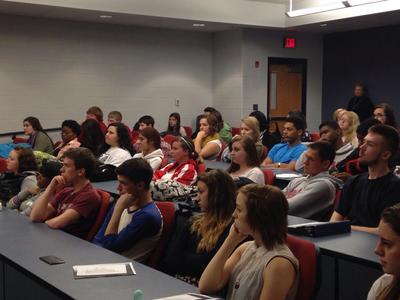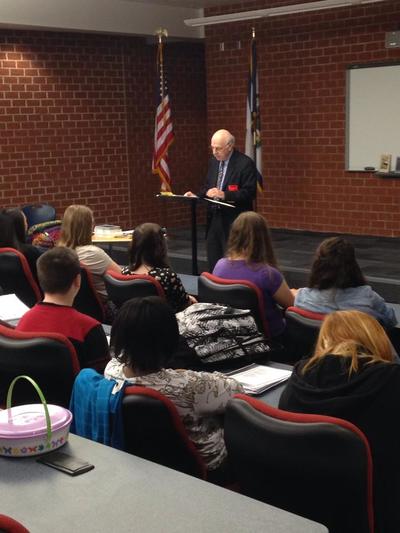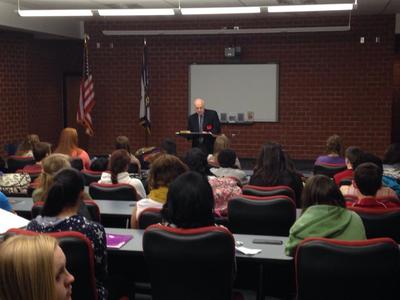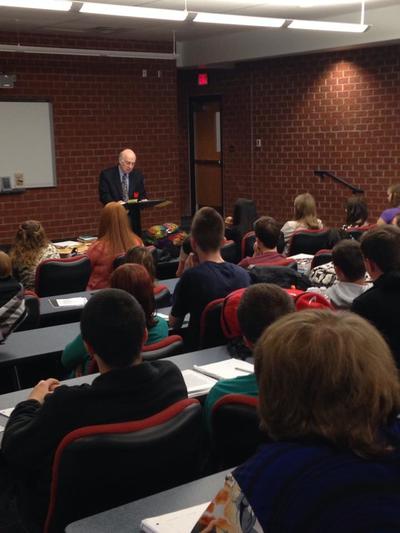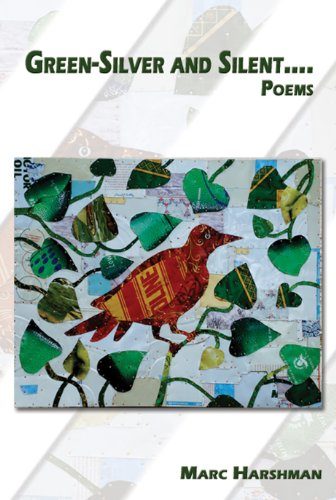
If you’re unfamiliar with the poetry of our extraordinarily talented West Virginia Poet Laureate, you need to add his work to your summer reading list this year. Marc Harshman is a West Virginia state treasure. An accomplished children’s book author, Harshman has also published two collections of poetry, Green-Silver and Silent and Believe What You Can. His work spans a wide range of complexities, and can be used in any ELA classroom at any level. I have had the pleasure of hosting him in my classroom several times, and I have used his poetry in my Advanced Placement Language and Composition course and in my English 11 class.
Here he is with my students below:
Harshman’s poetry sounds and feels as if Robert Frost and Walt Whitman took a hike together through the Appalachians. His poetry often explores our spiritual connection to the natural world, is rife with Appalachian themes, and filled with images of place, plants, animals, and people, his love of West Virginia evident in every turn of phrase. Often, his poems read like small celebrations of nature and beauty, highlighting the best of our people, our state, and our culture.
Take this one for example:
THERE WILL BE DANCING
A fiddle tune bearing, rough-shod,
the memory of the village:
sunlight on stucco,
leaf-plastered paths in autumn,
spectral sheep
in moonlight and bracken,
the lilt of the market tongue,
ancient beyond telling.
A fiddle tune bearing, sweet as fruit,
a memory of timelessness:
candles on narrow sills
marching each night through Advent,
a bowl of rose petals, peach
and orange and crimson,
garlic and lamb simmering
in a black pan,
kisses long enough for tasting.
All have returned, just here.
Listen. They come round again.
There will be dancing, too.
When I started working on this blog post, I was originally going to share a lesson I have used quite successfully that pairs Harshman’s A Song for West Virginia with Whitman’s Song of Myself. A Song for West Virginia was commissioned by the Wheeling National Heritage Area to celebrate the state’s sesquicentennial.
See Harshman perform the poem below:
**If you’d still like some details on that lesson, shoot me an email, and I’ll send them over.
(Also, here is a copy of some guided reading questions I came up with for A Song for West Virginia)
But I’m not going to focus this post on that lesson. Instead, I came up with something brand new. As I was re-reading Harshman’s collection, Green-Silver and Silent in preparation for this blog post, I was struck with inspiration. And like we all sometimes do in our classrooms, I switched gears.
You see, because my favorite Harshman poems are his prose style poems. They’re these wonderfully intense shorts, that read like flash-fiction.
Take SAVED for example:
SAVED
At Bible camp, climbing a steep bank, a boy, adventurous and confident, cries out to see a hornet’s nest and so draws them to him. White butterflies linger in the field, haphazard and intentional all at once and unmindful of the thick heat. The mud is cool down by the river where friends cake handfuls of it over the fiery welts that burn across his face, down his neck and snake along his spine. It was a wet spring and the river had cut a new path, deeper. It’s hard to believe anyone was every baptized here, but buried perhaps, yes. The boy’s whimpers die away as he crosses the soybean field on the shortcut back to camp where his counselor will joke that he looks like a mud pie. A green heron stays frozen at its work in the backwash below pale willows. They would have swung on grape vines near here, great living ropes that would have soared twenty feet out over the sluggish, seductive, waters of the stream. All in all a lucky day.
It was when I re-read SAVED that this post went off the rails. I re-read it a few times, and I couldn’t stop thinking about how this piece would be excellent as a model in a mentor text activity. We have talked about using mentor texts a few times on this blog, and for more information about using mentor texts, click HERE.
Harshman gets quite a bit done in just a few lines—lines loaded with imagery and symbolism. He tells us a whole story, but still leaves us with questions, wondering.
These nine sentences manage to do all the things we want our students to do in really great writing.
Take a look at another example from Green-Silver and Silent:
IN TIME FOR SUPPER
He flinches at the sight of his mother’s bra and panties strung along the still clothesline. No wind to enliven this afternoon. A truck is grinding its’ gears up inside the green shade of the mountain. Where the lawn meets the road the grass is brown with dust. A small garden snake slithers out onto the hot asphalt. His mother sleeps in front of the TV where John Wayne charges downhill, bugles blaring, sabers slicing the heavy air into thin wafers of breeze. Ahead, white flags surrender both pride and virtue. A change in the weather? The truck will reach Cumberland in time for supper. As he digs a grave for the snake, the boy will wonder again what it takes to become a man.
Again, nine sentences that tell an incredible story. Dripping with imagery and symbolism, I clearly saw a new lesson here for my students.
I wanted to craft a mentor task activity.
So–the new plan:
- Have students close their eyes. Read aloud SAVED or IN TIME FOR SUPPER. (You can start with either poem.) Have them concentrate on the images evoked by the poem. When you finish, they can jot down a few notes about what they saw in their minds eye during the reading.
- Next, pass the poem out.
- Have students read silently and look for noticings. Hopefully they will identify things like: imagery; symbolism; importance of title; focus on single, important event; short, loaded sentences; role nature plays in setting/plot/narrative; length of piece; prose style of the poem; etc.
- Discuss noticings.
- Now, show them the other poem and “lather, rinse, repeat.” Students need to take-away from discussion that place is a very important element in each piece, but also that the significance of the memory has amplified the details about place in the poems/stories for the narrators. Also discuss what makes these selections poetry and not prose. Is it the use of symbols? Figurative language? The nine sentence structure? Let the students argue their cases here. Some may feel more comfortable thinking about these pieces as vignettes rather than poems.
- Now, let’s model. Have students do some brainstorming first. Have them think of time in their own lives that something important or significant took place. Have them write down the event, and then every sensory detail they can remember about that day. Even the smallest details become important: cars backfiring, strange smells, the rough edges of the couch…
- And finally, using either of Harshman’s nine sentence models, have them imitate the structure and form of either SAVED or IN TIME FOR SUPPER, but write about their own significant events.
I can’t wait to try this in my own classroom, but since it’s the last week of school it may have to wait until August. If you try this lesson, tweet us, Facebook us, or Email us and let us know how it goes! And share great examples of student work!
In the meantime, grab copies of Green-Silver and Silent and Believe What You Can and read some more incredible work by our very talented Poet Laureate. You can also find Harshman and many other West Virginia writers in the brand new anthology, Eyes Glowing at the Edge of the Woods.
Happy reading, happy teaching, and happy (almost) Summer!
*All poems excerpted from Green, Silver, and Silent (2012) with the gracious permission of Marc Harshman, West Virginia Poet Laureate.
